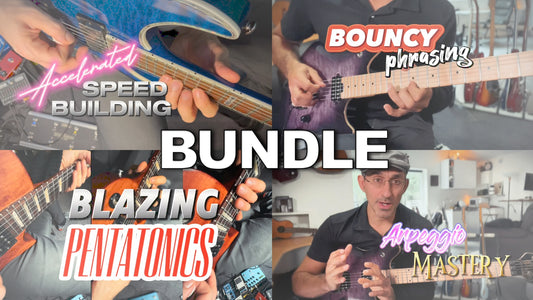Inside My Practice Routine: How I Actually Improve on Guitar
Share
How do you make sure your hands are playing together? How do you improve without just reinforcing bad habits? And how do you sound awesome at *both* slow and fast tempos? These are the exact questions I asked myself when I finally got some precious practice time after recovering from ear surgery, the flu, and a family ski trip.
In this video, I wanted to show you what actually goes on in my head while practicing. Because mindless practice? Nah. That stuff is useless. I'd rather have 10 focused minutes than 2 hours with the TV on in the background.
So I kicked off with some arpeggios - slow, even, clean. That’s where the heavenly tone lives. And if you’ve ever chased that Eric Johnson-style smoothness, the real secret is syncing your hands. Left-hand tone + right-hand pick = a kind of real-time overdub effect. One note played, but two notes felt.
And here's the thing - I never allow myself to practice with audible mistakes. If it’s sloppy, I stop. I fix it. I go again. Even after decades of playing, it’s *still* easy to slip into playing just above your comfort speed. But that’s a trap. Clean playing and great tone are what actually make you sound fast - because every note is clear, and that clarity fools the ear.
All of this practice is improvised in terms of harmony. I’m using arpeggios from E minor and E harmonic minor - what I call diatonic arpeggios. Think: pick every other note from the scale, and you’ve got yourself an arpeggio. Throw in some passing notes, maybe sneak a bit of scale back in, and suddenly it’s not robotic anymore - it’s musical.
I also adjust my technique on the fly. For example, if a barre chord introduces noise, I might shift to a string-skipping version or change the fingering completely. Clean tone always wins. And yes - I even had to change my approach because of a Band-Aid, ha!
Now, while the left hand gets a lot of attention, 50% of the magic comes from the right hand. I combine sweeping, hybrid picking, and hybrid legato depending on the situation. Because with arpeggios that span 1, 2, or 3 notes per string, rigid alternate picking doesn’t work. You have to stay flexible.
One of my favorite tricks? Preparing the next finger strike *before* the current one is finished. That makes hybrid picking bulletproof. It frees up my mental bandwidth to focus on coming up with fresh shapes and ideas with the left hand. It's about adapting your picking technique to fit your musical intention, not the other way around.
This short practice snippet is just one part of my full session. After warming up, I’d usually move on to the next area of focus - could be technique like economy picking, or more vibe-based stuff like capturing a groove I heard online. I haven’t practiced actual songs in over a decade. Instead, I practice *feel*. Style. Specific aspects of what I want to bring into my improvisation.
And of course, some sessions are just for jamming - letting all the focused elements melt together and hoping some of that hard work pays off naturally.
If you'd like to see more of this behind-the-scenes practice thinking, let me know. I'm happy to share more!
All the best,
Kris



